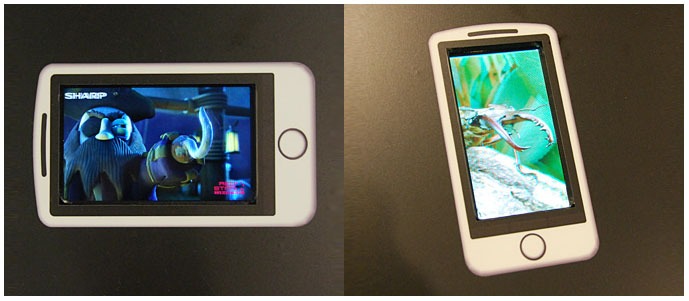 In the year when every mode of entertainment wants to go 3d: Gaming, Movies, TV broadcasts, mobile augmentation, none of the users want to wear those Soda Glasses. What is the way out?
In the year when every mode of entertainment wants to go 3d: Gaming, Movies, TV broadcasts, mobile augmentation, none of the users want to wear those Soda Glasses. What is the way out?
At this year’s Cebit, 3D without Glasses was first demonstrated on LCD TVs. But we don’t carry TVs everywhere. We need a revolution in mobile 3d. Nintendo 3DS turns out to do that well. But how about a screen that could be used on almost all the gadgets?
Sharp is working on an LCD panel for mobile devices that can render images with the illusion of 3D without requiring viewers to wear special glasses. The Screens will be ready for shipment later this year.
How will 3D on Mobile would work?
To get the 3D illusion viewers would need to hold the screen about 30 cm in front of them, thats exactly the same distance at which a cell phone or digital camera is typically held. Provided the angle is correct, they will see an image that appears to have depth (3D), else the image appears to be blurred.
However, if there are multiple viewers and you wish to showcase an important object on your phone to everyone around you, the screen can be switched between 3D and conventional 2D modes. This is made possible with a “switchable” layer inside the screen, called a parallax barrier, that splits light from the screen and directs it towards the right or left eyes when energized.
The company demonstrated 3D still images and animation on the screens.
The panel is the product of just under 20 years of 3D research and development by Sharp. The company has tried to commercialize such displays several times since 2001 but each time they failed to gain widespread acceptance.
Sharp now believes the time and technology are right. The new touch-sensitive screen is 3.4 inches across the diagonal. It is twice as bright as the 2001 models, and has about four times the resolution.
The 3D LCD developed by Sharp at this time significantly improves image quality by achieving both high brightness and low crosstalk(2) thanks to advances in CG-Silicon technology(3) and optimization of the parallax barrier. Advances in CG-Silicon technology have shrunk the wiring width within the LCD panel, allowing more light to pass and doubling the brightness (to 500 cd/m2, the industry’s highest) compared to the conventional model(4).
Sharp has also developed a non-touchscreen 3D LCD and will start its mass production in the first half of fiscal 2010.
Conventional 3D
Screen size 2.4 inches
Screen resolution (pixels) QVGA (240 x 320 pixels)
Brightness (2D mode) 250 cd/m2
Contrast ratio 100:1
Touchscreen function Without touchscreen
Newly Developed 3D LCD
Screen size 3.4 inches
Screen resolution (pixels) FWVGA (480 x 854 pixels)
Brightness (2D mode) 500 cd/m2
Contrast ratio 1000:1
Touchscreen function With touchscreen / without touchscreen
Difference from conventional 3D LCD
Screen size --
Screen resolution (pixels) Approx. double in both horizontal and
vertical resolution
Brightness (2D mode) Approx. double
Contrast ratio Approx. 10 times greater
Touchscreen function --More on 3D, HDTVs, Gagdets, iPhone, Open Source, Latest in web via @taranfx on twitter and below:
loading...
loading...

